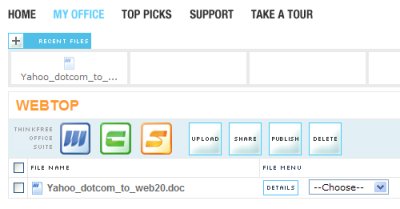ThinkFree review Pt 2 - and Java vs Ajax discussion

I recently spoke to ThinkFree CEO TJ Kang and this is Part 2 in a two-part series based on that conversation. Java is more efficient than Ajax for advanced Web Office functionality In my previous post I took a high-level look at ThinkFree and its place in the Web Office market. Today I look into the product itself. Fellow ZDNet blogger Marc Orchant reviewed ThinkFree recently too, as did Dan Farber in March. So I'm aware that ThinkFree has had a decent amount of coverage on ZDNet already, however I intend to cover all the other main Web Office/WebOS contenders too - just so you know.
ThinkFree is easy to get started and should be good to go within a few minutes of signing up. Central to the service is a concept called 'Webtop', which is basically an Office desktop - but (as the name implies) on the Web. There are 3 main office applications which ThinkFree offers: word processing, spreadsheet and presentation. All of them are compatible with Microsoft Office - and indeed ThinkFree uses almost identical icons (blue Word-like icon for word processing, etc).

There are two types of editing: Quick Edit and Power Edit. For word processing, the Quick Edit is the Ajax version of the editor. The spreadsheet and presentation apps don't yet have Ajax Quick Editors, but TJ told me they're coming (an Ajax spreadsheet editor in June and the presentation one coming later). Note that all 3 apps have an Ajax viewer. But as of now the word processor is the only one with an Ajax Quick Editor.
The 'Power Edit' options over the 3 office apps are ALL Java-based. As TJ explained to me, currently the best way to offer advanced Web Office functionality is to utilize Java. Ajax doesn't cut it when it comes to advanced functionality. Although in theory you can build it in Ajax, said TJ, the resulting code will be so big that it will take ages to download stuff and slow the system considerably. So Java is, according to TJ, much more efficient than Ajax when it comes to implementing Microsoft Office-like functionality.
Note also that the Java applets only need to get downloaded onto your machine when you edit something (other than the Ajax-powered word Quick Editor). TJ pointed out that you can search, share, view, tag, and comment on documents - all without a Java download being necessary. Nevertheless, it is necessary once you get to the advanced functionality offered by Power Edit and (right now) with the two non-Word quick edits.
When I tried the Quick Edit for word processor, it came up with a notice warning that formatting may not be preserved. But I had no problem editing the test document. Although it's true that relatively slow processing and possible network issues are downsides to Web Office apps, the upside is the collaboration and sharing capabilities of web-based docs. Plus Marc Orchant nicely summarized the cross-platform workflow possibilities for ThinkFree. All up, I found ThinkFree's publishing and sharing facilities to be smooth and feature-rich.
The primary benefit at this point in time of ThinkFree is its close compatibility to Microsoft Office functionality - and the web-based functionality, such as collaboration, that it offers on top of that. The performance and network issues for Web Office suites are of course not trivial in 2006 - especially for enterprise IT departments who are usually bound by tight SLAs by their businesses. But although Web Office is not ready to usurp Microsoft Office just yet, I believe ThinkFree is nicely positioned to ramp up once the Web platform becomes a bit more stable.